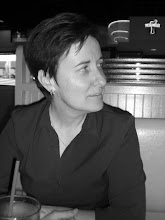My rating: 5 of 5 stars
As a former resident of Southern California who has often wondered how L.A. area got to be so congested, so disorganized, and so bogged down with freeways, Jeremiah B.C. Axelrod's fascinating new book, Inventing Autopia: Dreams and Visions of the Modern Metropolis in Jazz Age Los Angeles provided me with some answers.
Contrary to popular belief, the sprawl that characterizes the L.A. area did not just spring up in a haphazard fashion. Instead, as Axelrod argues, this pattern of development resulted from the process of conflict over competing visions of the possible.
Going back to the early 20's, planners in L.A. were divided between two camps. One group sought a concentric model of L.A. with a downtown business zone and outlying areas devoted to suburbs (think of a target with the bull's eye as the downtown region and the series of circles spreading out). This model dominated the major Eastern metropolis such as Chicago and New York City.
The other model, based on utopian visionary Ebenezer Howard's notion of "the garden city", offered a different view of urban development. Howard proposed the garden city as an alternative to the alienation of the modern city "to disrupt and debunk the concentric emphasis on the city by replacing it with an ideal of self-contained towns ordered on a more human scale." In this way, "the garden city would be tailored to promote social familiarity and community interaction instead of alienation and impersonality endemic to the metropolis." This vision of L.A. sought to provide residents with a more humane balance to the onward march of modernity.
Axelrod's analysis traces how the social and political clash of these competing ideologies resulted the establishment of Southern California as a "postsuburban region." Rob Kling, Spencer Olin and Mark Poster characterize this pattern of development as "the fundamentally decentralized spatial arrangement...in which a variety of commercial, recreational, shopping, arts, residential, and religious activities are conducted in different places, linked primarily by private automobile transportation." (p. 221)
For a detailed analysis of this phenomenon readers are encouraged to check out their book, Postsuburban California: The Transformation of Orange County since World War II.
The impact of these changes are still being experienced today, not only in Southern California, but across the country. Axelrod has provided us with a highly readable and informative analysis to help us better understand how "postsuburbia" became the dominant model for communities. Recommended for those who struggle each day with lengthy commutes, congested communities and seemingly never-ending development. If you've ever wondered how did it get this way, this is the book for you.
View all my reviews >>




No comments:
Post a Comment